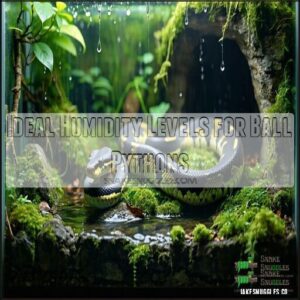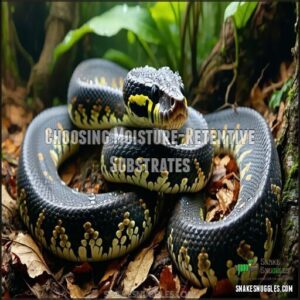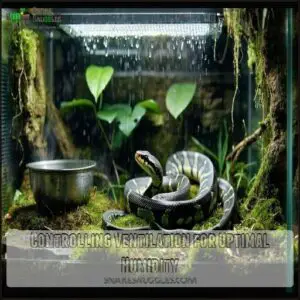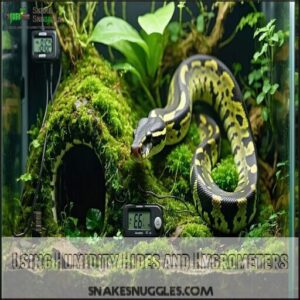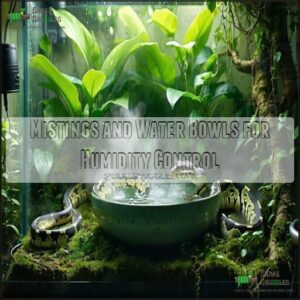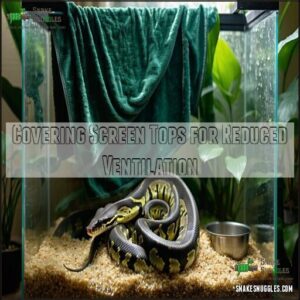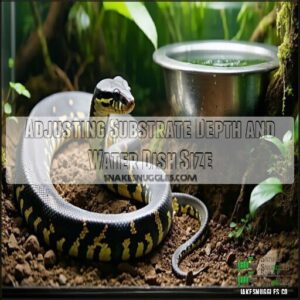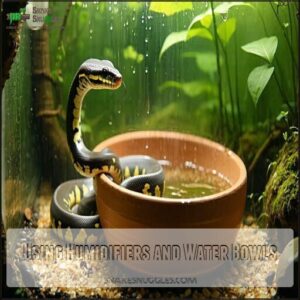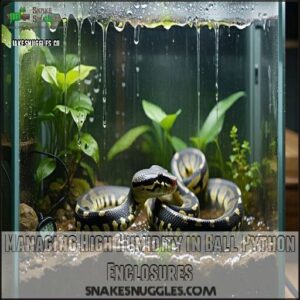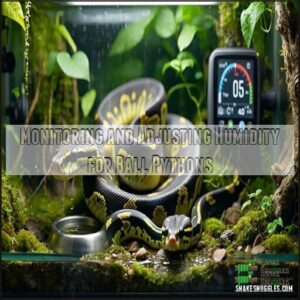This site is supported by our readers. We may earn a commission, at no cost to you, if you purchase through links.

During the day, aim for around 60-70% humidity, but don’t panic if it occasionally jumps to 80%.
At night, humidity can spike up to 100%, which helps prevent respiratory issues and supports smooth shedding.
You’ll need to monitor these levels closely with a hygrometer. Too dry, and your snake might struggle to shed; too wet, and you’re risking potential health problems.
Pro tip: substrate choice and occasional misting can help you maintain that perfect moisture balance.
Table Of Contents
- Key Takeaways
- Ideal Humidity Levels for Ball Pythons
- Maintaining Humidity in Ball Python Enclosures
- Increasing Humidity in Ball Python Tanks
- Managing High Humidity in Ball Python Enclosures
- Monitoring and Adjusting Humidity for Ball Pythons
- Frequently Asked Questions (FAQs)
- What is a good humidity level for ball pythons?
- How humid should a ball python terrarium be?
- What temperature should a ball python be?
- How humid should a ball python enclosure be?
- What happens if a ball python has low humidity?
- How do you maintain humidity in a ball python?
- What is the ideal humidity level for ball pythons?
- Is 70 humidity too high for ball python?
- Is 45 humidity too low for ball python?
- What should the humidity be in a ball python tub?
- Conclusion
Key Takeaways
- You’ll need to maintain a humidity range of 60-80% for your ball python, with daily levels around 60-70% and nighttime levels up to 80-100% to mimic their natural habitat and support their health.
- Your substrate choice is critical – materials like cypress mulch and coco fiber help retain moisture and create the perfect humidity gradient, so you’ll want to choose wisely and maintain a depth of 4-7 inches.
- You can’t manage humidity effectively without a reliable hygrometer, which lets you track moisture levels precisely and make strategic adjustments to prevent shedding issues and respiratory problems.
- During shedding, you’ll want to boost humidity to around 70% and create a dedicated humidity hide with damp sphagnum moss to help your ball python’s skin slip off smoothly and prevent complications.
Ideal Humidity Levels for Ball Pythons
You’ll want to create the perfect humidity environment for your ball python to keep them healthy and thriving.
Maintaining humidity levels between 55-80% is important for your snake’s well-being, helping prevent shedding issues and respiratory problems while mimicking their natural habitat.
Understanding Humidity Ranges for Ball Pythons
Exploring the humidity ranges for ball pythons reveals the delicate balance of their natural habitat.
These alluring serpents thrive in environments mimicking their native conditions.
Here’s what you need to know:
- Ball pythons prefer 60-80% humidity
- Natural habitats experience high moisture levels
- Humidity impacts respiratory health
- Precise measurement is paramount for snake wellness
Monitoring and adjusting humidity makes certain your scaly friend stays healthy and happy.
Ideal Day and Night Humidity Levels
Mastering your ball python’s diurnal humidity requires precision.
During the day, maintain 50-60% humidity to keep your scaled friend comfortable.
When night falls, let those levels climb to 80-100%, mimicking their wild habitat.
Here’s how to nail those humidity requirements:
- Track changes with a reliable hygrometer
- Create smooth humidity gradients
- Leverage moisture-rich substrates
- Embrace natural humidity cycling
Humidity Levels During Shedding
Regarding ball python shedding, you’ll want to dial up the humidity in one swift move.
Boost moisture levels to around 70% to help your snake’s skin slip off smoothly.
A humidity hide packed with damp sphagnum moss works wonders.
Mist daily, watch for shedding signs, and keep that hygrometer close to track your python’s comfort zone.
Risks of Low and High Humidity
A ball python’s humidity drama can turn serious fast. Low moisture levels invite respiratory infections and stubborn shedding problems, while high humidity breeds bacterial nightmares and scale rot. Your reptile’s health hangs in the balance.
- Watch humidity levels like a critical lifeline
- Inspect enclosure moisture daily
- Respond quickly to environmental changes
- Prioritize your python’s comfort
Dehydration isn’t just inconvenient—it’s dangerous.
Maintaining Humidity in Ball Python Enclosures
You’ll need to master humidity control to keep your ball python healthy and thriving in captivity.
By understanding how to manage moisture levels, substrate choices, and environmental factors, you can create the perfect habitat that mimics your snake’s natural tropical environment.
Choosing Moisture-Retentive Substrates
Your snake’s sanctuary starts with smart substrate selection.
The right bedding isn’t just ground cover—it’s a humidity highway!
Cypress mulch and coco fiber reign supreme for moisture management.
| Substrate | Depth | Maintenance |
|---|---|---|
| Cypress Mulch | 4+ inches | Spot Clean |
| Coco Fiber | 4+ inches | Frequent Mist |
| Paper Towels | 0.5-1 inch | Regular Change |
Keep your python’s home perfectly humid with these moisture-retaining champions.
Controlling Ventilation for Optimal Humidity
After carefully selecting your substrate, it’s time to master ventilation placement in your snake’s home.
Master your snake’s comfort with strategic ventilation—small screen gaps are your humidity’s secret weapon.
Small screen gaps help regulate humidity levels without compromising airflow.
Position your water dish strategically near heat sources to create a natural humidity gradient.
Experiment with enclosure size and airflow direction, making seasonal adjustments as needed.
Monitor changes closely and tweak your setup for peak snake comfort.
Using Humidity Hides and Hygrometers
Crafting the perfect humidity hide requires strategic thinking and precise monitoring.
Choose smooth-surfaced, moisture-retaining materials like sphagnum moss for your ball python’s comfort.
Position hygrometers at different tank levels to track humidity variations accurately.
Many pet owners purchase reptile humidity control products online.
Regular calibration guarantees reliable readings, helping you troubleshoot and maintain ideal humidity conditions for your scaly friend’s health.
Mistings and Water Bowls for Humidity Control
After setting up your hygrometer, humidity management becomes an art of precision.
Here’s how to master it:
- Mist gently once or twice daily for balanced moisture.
- Choose wide, large water bowls to boost humidity.
- Position water dishes near heat sources for faster evaporation.
- Use strategic bowl placement to create microclimate zones.
Consistent monitoring can help prevent respiratory health issues.
Increasing Humidity in Ball Python Tanks
You’ll need to master several techniques to increase humidity in your ball python’s tank and keep your scaly friend healthy.
From covering screen tops to adding moisture-retaining substrates and strategically placing water bowls, you’ll learn simple methods to create the perfect humid environment for your snake.
Covering Screen Tops for Reduced Ventilation
Your ball python’s screen top is a humidity control goldmine. By partially covering it with materials like towels or plastic wrap, you’ll create a microclimate that traps moisture without suffocating your pet.
Strategic coverage reduces ventilation, boosts humidity levels, and keeps your reptilian friend comfortable.
| Material | Ventilation Impact | Humidity Boost |
|---|---|---|
| Towel | Moderate Reduction | Gradual Increase |
| Plastic Wrap | Significant Block | Substantial Rise |
| Mesh Screen | Minimal Change | Limited Effect |
| Glass Lid | Complete Block | Maximum Retention |
| Foil Cover | Extreme Reduction | Rapid Moisture Surge |
Adding Humidity Hides With Moist Sphagnum Moss
After blocking air flow, boost your python’s comfort with a humidity hide packed with sphagnum moss.
This clever trick helps maintain ideal moisture levels.
Here’s how to create the perfect sanctuary:
- Choose fresh, high-quality sphagnum moss for maximum moisture retention
- Select a hide with smooth, snug walls to trap humidity
- Consider sphagnum moss products for superior results.
- Replace moss monthly to prevent bacterial growth and keep your snake healthy
Adjusting Substrate Depth and Water Dish Size
The magic of ball python humidity often lies in the subtle details of substrate depth and water dish size.
Your substrate’s ability to retain moisture can make or break your snake’s comfort zone.
Opt for deep substrates like eco earth or reptisoil, aiming for 7-8 inches to create a natural humidity gradient. Substrate saturation becomes key in maintaining consistent moisture levels.
Choose larger water dishes strategically—their placement and material can greatly impact evaporation rates. In adult ball python enclosures (48" x 24" x 24"), a well-positioned dish can transform humidity maintenance.
Remember, depth benefits extend beyond mere moisture—they provide insulation and security.
Maintaining proper humidity prevents respiratory health issues.
By understanding these nuanced techniques, you’ll master the art of snake enclosure humidity with confidence.
Using Humidifiers and Water Bowls
After fine-tuning your substrate depth, boosting humidity becomes your next mission.
Opt for a large ceramic water bowl placed on the warm side—this encourages evaporation and raises humidity levels.
Adult ball pythons thrive with a 16-oz bowl.
Consider an automated humidifier for consistent moisture, but manual misting works too.
Many owners find that a python humidifier is helpful for maintaining proper humidity.
Room-temperature water keeps things simple, and frequent cleaning prevents bacterial growth.
Managing High Humidity in Ball Python Enclosures
If you’re battling excessive humidity in your ball python’s enclosure, you’ll need strategic techniques to bring those moisture levels down.
By carefully controlling ventilation, substrate choice, and water dish placement, you can create the perfect, balanced environment for your scaly friend.
Increasing Ventilation for Lower Humidity
When excess humidity becomes a concern, smart ventilation is your solution.
Install strategic vents on opposite tank sides—one high on the hot end, another low on the cool end—to create natural, cross-tank airflow.
This technique helps moisture escape without compromising your snake’s comfort. Remember that proper humidity aids in healthy shedding.
Strategic ventilation doesn’t mean exposing your ball python to drafts; it’s about controlled, gentle air circulation that maintains a healthy environmental balance while preventing humidity buildup.
Switching to Drier Substrates for Humidity Control
Are high humidity levels making your ball python’s habitat feel like a swamp?
It’s time to swap your moisture-loving substrate for drier alternatives. Opt for lignocel or beech chips, which naturally absorb less water and help maintain prime ball python humidity levels.
These substrates offer faster drying times and reduce respiratory concerns associated with excessive moisture.
By choosing a thinner substrate layer—around 2-3 inches deep—you’ll create a more breathable environment that prevents shedding difficulties and supports your snake’s health.
Think of it as giving your ball python a drier, more comfortable home. Pro tip: regularly monitor substrate conditions to guarantee consistent humidity control and your snake’s well-being.
Using Smaller Water Dishes for Reduced Humidity
Battling high humidity in your ball python’s home? Your water dish might be the culprit! Shrinking its size can dramatically reduce moisture levels.
- Choose a compact water dish
- Position it away from heat sources
- Select shallow, narrow containers
- Clean frequently to prevent bacterial growth
- Monitor evaporation surface carefully
By strategically sizing down your python’s water container, you’ll create a more balanced environment. Remember, less surface area means less moisture—keeping your scaly friend comfortable and healthy.
Maintaining Constant Temperatures
The temperature symphony in your ball python’s habitat demands precise orchestration.
Use heat mats with reliable thermostats to create a strategic temperature gradient.
Your basking spot should sizzle at 90-95°F, while warm hides maintain 86-90°F and cool zones hover around 72-80°F.
When night falls, let temperatures gently drop to 70-78°F, mimicking natural thermal cycles.
Careful heating element placement guarantees your snake’s comfort and metabolic stability.
Monitoring and Adjusting Humidity for Ball Pythons
You’ll need to become a humidity detective to keep your ball python healthy and thriving.
By understanding how to monitor and adjust the humidity levels in your snake’s enclosure, you’ll create a comfortable environment that supports your pet’s well-being and prevents potential health issues. Complete concepts are important.
Regular Hygrometer Readings for Humidity Monitoring
Hygrometer monitoring is your snake’s climate control lifeline. A digital hygrometer delivers the most precise humidity tracking for your ball python’s habitat.
Track humidity like a detective, and your ball python will thank you with vibrant health and smooth sheds.
Here’s your game plan:
- Check readings twice daily, morning and night
- Position hygrometer at snake level for accuracy
- Calibrate every 6 months to maintain hygrometer reliability
Mastering humidity monitoring isn’t rocket science—it’s about staying consistent. Your digital buddy will help you create the perfect environment, making sure your scaly friend feels right at home.
Think of it as being a humidity guardian, one reading at a time. These snakes thrive with proper humidity levels necessary.
Adjusting Environment Based on Ball Python Health
After tracking your hygrometer’s readings, you’ll want to become a detective of your ball python’s health signals.
These clues reveal critical humidity insights that keep your snake thriving.
| Health Signal | Possible Cause | Recommended Action |
|---|---|---|
| Stuck Shed | Low Humidity | Increase moisture |
| Wheezing | High Humidity | Improve ventilation |
| Wrinkled Skin | Dehydration | Adjust water sources |
Listen to your snake’s body language—it’ll tell you exactly what environmental tweaks are needed. Stuck Shed, Low Humidity, Increase moisture.
Providing Secure Humidity Hides for Shedding
When your ball python starts shedding, a well-designed humidity hide can be a game-changer.
Choose a plastic container with a snug entrance, ensuring it’s just big enough for your snake to curl up comfortably.
Line it with damp sphagnum moss on the warm side of the enclosure, creating a cozy microclimate that helps soften scales and support a smooth shedding process.
This dedicated humidity hide gives your snake a perfect retreat during vulnerable shedding times.
Using Fans for Improved Air Circulation and Humidity Control
A whisper of air can transform your ball python’s habitat.
Strategic fan placement creates favorable airflow patterns that support humidity control without stressing your snake.
Use small, quiet fans positioned to create gentle circulation—one drawing fresh air in, another pulling stale air out. This approach helps manage evaporation rates and establish a balanced humidity gradient.
Avoid direct drafts that might chill your snake. Different fan types can help regulate ventilation, making certain your ball python’s environment stays comfortable and healthy.
Careful airflow management is key to maintaining ideal habitat conditions.
Frequently Asked Questions (FAQs)
What is a good humidity level for ball pythons?
In snake habitats, 60-80% humidity keeps your ball python thriving.
You’ll want to maintain this range, adjusting slightly during shedding.
A reliable hygrometer helps you track these moisture levels precisely and easily.
How humid should a ball python terrarium be?
You’ll want to keep your ball python’s terrarium between 55-80% humidity, with a sweet spot around 60-70%.
Mist regularly, use a large water dish, and monitor with a hygrometer to guarantee your scaly friend stays healthy and comfortable.
What temperature should a ball python be?
Did you know most ball pythons thrive in a cozy 80-85°F range?
You’ll want to create a warm side near 88-92°F and a cooler side around 76-80°F, ensuring your scaly friend stays comfortable and healthy.
How humid should a ball python enclosure be?
You’ll want to keep your ball python’s home between 55-80% humidity, with a sweet spot around 60-70%.
During shedding, bump it up to 70-80%.
Use a hygrometer to track levels and adjust accordingly for your snake’s comfort.
What happens if a ball python has low humidity?
In the desert of dry air, your ball python’s health withers like a delicate flower.
Low humidity causes shedding nightmares, respiratory issues, and weakened defenses, potentially leading to serious health complications for your scaly companion.
How do you maintain humidity in a ball python?
You’ll maintain humidity by misting your enclosure, using a large water dish, and adding moisture-retaining substrates like cypress mulch.
Check humidity levels with a hygrometer and adjust as needed for your ball python’s comfort.
What is the ideal humidity level for ball pythons?
Like a desert flower craving moisture, your ball python thrives in 55-80% humidity.
You’ll want to aim for 60-70% daily, bumping it to 80% during shedding to keep your scaly friend healthy and comfortable.
Is 70 humidity too high for ball python?
70% humidity isn’t too high for your ball python.
It’s actually perfect, especially during shedding.
Just make certain it doesn’t consistently stay above 80%, which could lead to respiratory issues or bacterial growth in the enclosure.
Is 45 humidity too low for ball python?
Your snake’s world feels too dry at 45% humidity.
Danger lurks in this parched environment, risking shedding struggles and respiratory issues.
You’ll want to boost moisture levels quickly to keep your scaly friend healthy and thriving.
What should the humidity be in a ball python tub?
In your ball python tub, aim for 55-80% humidity.
You’ll want a digital hygrometer to track levels.
Mist the substrate, use a water bowl, and create a humidity hide to keep your snake comfortable and healthy.
Conclusion
Nurturing a ball python’s habitat is like crafting a delicate ecosystem where ideal humidity for ball pythons becomes your secret weapon.
Master the art of moisture management, and you’ll create a thriving sanctuary for your scaly friend.
By monitoring humidity levels, using strategic techniques, and staying attentive to your snake’s needs, you’ll guarantee a healthy, comfortable environment that supports their natural behaviors and overall well-being.
- https://www.reptilecentre.com/blogs/reptile-blog/5-ways-to-increase-humidity-for-reptiles
- https://www.aussiepythons.com/threads/diy-snake-enclosure-help-would-this-be-enough-air-ventilation.175070/
- https://reptile.guide/ball-python-humidity/
- https://pmc.ncbi.nlm.nih.gov/articles/PMC6021098/
- https://reptifiles.com/ball-python-care-guide/ball-python-humidity-temperatures/

